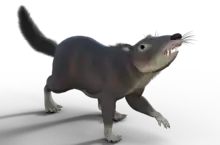Chronoperates
Chronoperates (meaning "time wanderer" in Greek) is an extinct genus of mammal whose remains have been found in a late Paleocene deposit in Alberta, Canada. It is represented by the type species Chronoperates paradoxus and known only from a partial left lower jaw.[1] It was first identified in 1992 as a non-mammalian cynodont, implying a ghost lineage of over 100 million years since the previously youngest known record of non-mammalian cynodonts, which at that time was in the Jurassic period (some non-mammalian cynodonts are now known to have persisted until the Early Cretaceous). Subsequent authors have challenged this interpretation, particularly as the teeth do not resemble any known non-mammalian cynodonts. Chronoperates is now generally considered to be more likely to be a late-surviving symmetrodont mammal. This would still infer a ghost lineage for symmetrodonts, but a more plausible one, as symmetrodonts persisted into the Late Cretaceous.
| Chronoperates | |
|---|---|
| Scientific classification | |
| Kingdom: | Animalia |
| Phylum: | Chordata |
| Class: | Mammalia |
| Order: | †Symmetrodonta (?) |
| Family: | †Chronoperatidae Fox, Youzwyshyn & Krause, 1992 |
| Genus: | †Chronoperates Fox, Youzwyshyn & Krause, 1992 |
| Type species | |
| †Chronoperates paradoxus Fox, Youzwyshyn & Krause, 1992 | |
References
- Fox, Richard C.; Youzwyshyn, Gordon P.; Krause, David W. (1992). "Post-Jurassic mammal-like reptile from the Palaeocene". Nature. 358 (6383): 233–235. Bibcode:1992Natur.358..233F. doi:10.1038/358233a0. PMID 1630490. S2CID 4241895.
http://darrennaish.blogspot.com/2006/05/time-wandering-cynodonts-and-docodonts.html https://web.archive.org/web/20081219051716/http://www.palaeos.com/Vertebrates/Units/410Cynodontia/410.400.html





